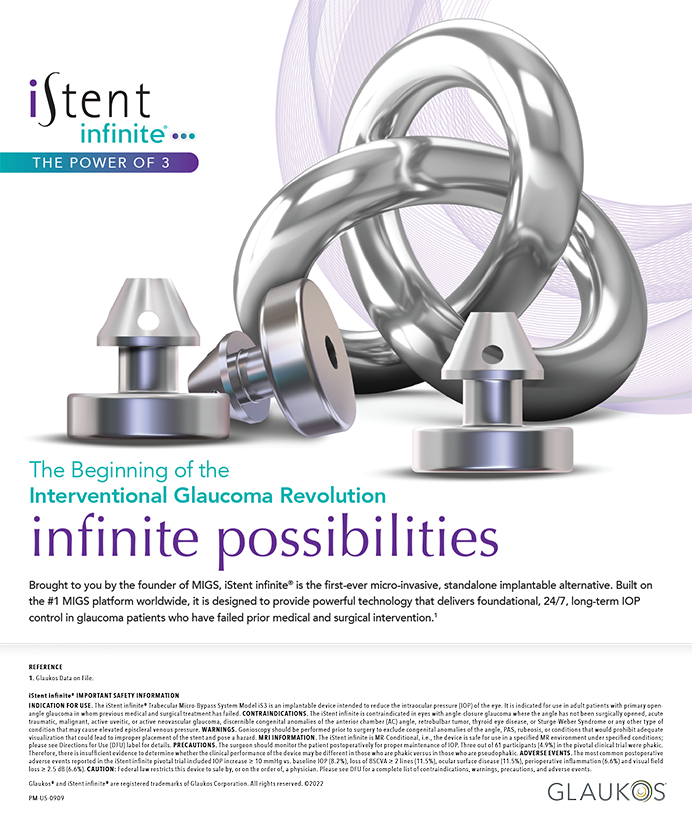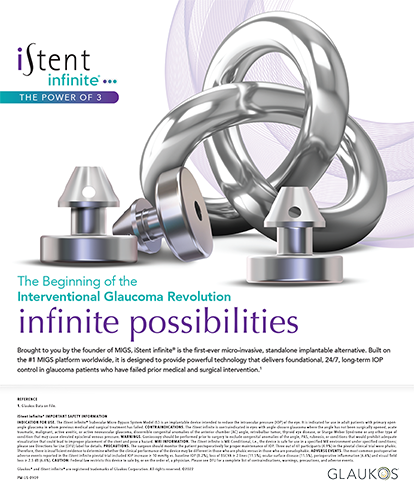The past 10 years have been revolutionary for corneal transplantations. Lamellar surgery has replaced full-thickness procedures for many corneal diseases. Anterior lamellar keratoplasty, both superficial and deep, has become widely accepted because it preserves the host endothelium, thereby reducing the rejection and long-term endothelial loss invariably seen with full-thickness grafts.1 This popularity comes despite the greater surgical deftness required by these partial-thickness dissections. Similarly, endothelial keratoplasty (EK) is the new surgical standard for corneal endothelial disease. Without full-thickness trephinations, EK avoids many pitfalls of penetrating keratoplasty such as high irregular astigmatism, a neurotrophic surface, and wound/suture issues.
EK evolved from the original manually dissected procedures for both donor and host to become the most commonly performed procedure to treat corneal endothelial disease: Descemet stripping automated keratoplasty (DSAEK). Descemet membrane endothelial keratoplasty (DMEK) represents the next advance.
DESCEMET STRIPPING AUTOMATED KERATOPLASTY
DSAEK involves stripping only the diseased endothelial- Descemet layer and replacing it with a donor posterior stromal-Descemet-endothelial layer that is cut with the keratome. The elimination of all manual dissection (stripping the host and maximizing the smoothness of the donor by using the keratome) improves visual recovery. Fewer than 20% of patients, however, recover 20/20 visual acuity after DSAEK.
Total corneal thickness grows by an average of 125 to 150 μm with the addition of the donor layer, but most studies have found that this increase does not adversely affect visual acuity. DSAEK, however, still involves a lamellar dissection of the donor. Although the resultant surface is smoother than after manual dissection, it is nowhere near the smoothness achieved by Descemet peeling.
Proponents of ultrathin DSAEK (less than 80-μm donor thickness) claim superior visual outcomes, but stromal keratome dissection is by its very nature irregular. This irregular interface is the major factor in patients’ suboptimal visual recovery, and remodeling is the reason DSAEK results continue to improve years later.
DESCEMET MEMBRANE ENDOTHELIAL KERATOPLASTY
DMEK takes the elimination of stromal dissections to the next level. There are none! If the goal of any surgery is to reduce collateral damage, DMEK is the ultimate procedure (Figure). The diseased Descemet-endothelial layer is replaced with the exact donor layers, no more, no less. The interface is truly smooth. Not only do more than 50% of patients recover 20/20 visual acuity, but they do so in 4 to 6 weeks. Compared with DSAEK, other significant advantages of DMEK include smaller wounds, a minimal refractive shift, and less rejection.1
The procedure’s downside is twofold: issues related to donor loss and the learning curve. Eye banks are only too eager to solve the former problem by supplying prepeeled donors. The learning curve is formidable, but so is that of DSAEK, which is currently the standard of care. Yes, the incremental benefit of DMEK versus DSAEK is far less than that of DSAEK versus penetrating keratoplasty. The upside, though, is that a failed DMEK can always be repeated with DSAEK without any adverse anatomical sequela.
IDEAL PATIENTS
As with DSAEK, the selection of patients is key to success with DMEK. The latter procedure is highly recommended for eyes with isolated endothelial disease but normal anterior segments, including those with Fuchs dystrophy, pseudophakic bullous keratopathy, iridocorneal endothelial-type syndromes, or a history of failed DSAEK. Eyes that have undergone vitrectomy are less desirable, because shallowing of the anterior chamber is essential to unfolding donor tissue. Abnormal irides are another contraindication; pupils must be able to constrict and lack large iridectomies. A patient’s inability to lie supine for several hours each day for 2 to 3 days postoperatively is another contraindication. Filters and tube shunts are not exclusions for experienced surgeons. Patients who are older than 50 should be rendered pseudophakic first or simultaneously, and an anterior chamber IOL is not acceptable. The aforementioned exemptions are not set in stone, but the chance of surgical complications will push the risk-benefit ratio toward DSAEK.
Like DSAEK, DMEK does not eliminate the controversies of operating on an eye with a clear lens or combined versus staged lens surgery. DMEK does allow consideration of an elective upgrade for superior refractive outcomes through astigmatic correction, however, because the incision is phaco sized. No study on multifocal IOLs in conjunction with DMEK has been conducted, so these lenses are not recommended in this setting.
IDEAL DONORS
Donor selection for DMEK and DSAEK differs slightly. Rim size is unimportant in DMEK, because there is no keratome cut requiring fixation to an artificial chamber. Donors younger than age 50 are not recommended. Although peeling is no different than in older donors, the younger tissue forms much tighter curls, which makes unfolding more difficult. In addition, young donor tissue may be more prone to dislocation because of its greater elasticity and tendency to curl. The difficulty of a donor peel is specific to the tissue itself, as indicated by tenacious adhesions and a higher tear rate in pairs from the same donor.1 If tissue from one eye of a donor proves unusable, the mate donor should be used for DSAEK so as not to risk two donor losses.
Although the success rate of donor peeling approaches 97% among highly experienced surgeons,1 again, donor loss can be solved with eye bank peeling.
DISLOCATIONS
“Rebubbling” after DMEK is different than after DSAEK: almost always partial after the former procedure versus almost always complete after the latter. Partial rebubbling allows just peripheral, not visually significant separations to be observed. Most dislocations fall into this category, which reduces the rebubbling rate with DMEK to less than 5%.1
The edema overlying a donor gap obscures the surgeon’s visualization of the donor curl. Without corneal optical coherence tomography, this author assumes it is separated and rebubbles if visually significant. Rebubbling should also involve uncurling the donor, just as in surgery, so as not to pin the folded edge against the stroma. Total edema results from primary failure, an inverted donor, or total dislocation (seen as a curled roll in the anterior chamber). Anterior segment optical coherence tomography can be very helpful in these cases, and in all three scenarios, repeat surgery is likely. Whether air or SF6 gas is used, postoperatively, intermittent supine positioning of the patient is recommended while the bubble is present.
CONCLUSION
Surgical videos do not replace personal mentoring in the OR. This brief review has not detailed the many surgical nuances unique to DMEK, including host stripping, donor injection, unfolding, and postoperative bubble care. The article does, however, outline DMEK’s key advantages and limitations. The improved visual outcomes of this procedure should increase its adoption. DSAEK’s maturation into a predictable, highly successful procedure, however, may delay this conversion.
DMEK is not the last evolutionary branch of the corneal endothelial transplant tree. Biological restitution of the endothelium has already been reported and may be the final advance for which surgeons and their patients have been waiting.
Mark S. Gorovoy, MD, is in private practice with Gorovoy MD Eye Specialists in Fort Myers, Florida. Dr. Gorovoy may be reached at (239) 939-1444; mgorovoy@gorovoyeye.com.
- Gorovoy MS. DMEK complications. Cornea. 2013;33:101-104.


